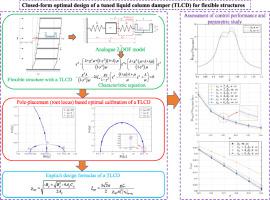International Journal of Mechanical Sciences ( IF 7.1 ) Pub Date : 2021-03-04 , DOI: 10.1016/j.ijmecsci.2021.106364 Bei Chen , Zili Zhang , Xugang Hua

|
The conventional optimal calibration of a TLCD for suppressing structural vibration is based on the classic 2-degrees-of-freedom (2-DOF) model in terms of one specific structural mode (usually the resonant mode). For flexible multi-degrees-of-freedom (MDOF) structures, this implies that background flexibility contribution from other non-resonant modes is omitted, resulting in an unbalance in the frequency response of the flexible structure-TLCD coupled system. Furthermore, numerical search techniques are usually used for optimizing TLCDs, and extensive computational efforts are required. Therefore, in this paper a novel closed-form optimal calibration procedure accounting for the background flexibility contribution from the flexible structure is developed based on the pole-placement method. The background flexibility is represented by an equivalent stiffness that is derived from modal analysis. An analogue 2-DOF model accounting for background flexibility is developed, which turns out to be a generalization of the classic 2-DOF model. The root locus analysis is performed to derive the optimal frequency ratio of the TLCD by the equal modal damping ratio criterion. A straightforward approach for determining the optimal head loss coefficient is proposed based on the bifurcation point present in the root locus. It is seen from the closed-form formulas that the optimal parameters of the TLCD depend not only on the constructive parameters (such as the mass ratio and horizontal length ratio of a TLCD) but also on the structural inherent characteristics. Application to MDOF flexible structures are illustrated by a 10-story shear frame. Results demonstrates that the proposed calibration procedure leads to a balanced frequency response curve and thus improves the performance of the TLCD comparing with the calibration procedure ignoring background flexibility.
中文翻译:

挠性结构的可调液柱阻尼器(TLCD)的封闭形式最佳校准
用于抑制结构振动的TLCD的常规最佳校准基于经典的2自由度(2-DOF)模型,即一种特定的结构模式(通常是共振模式)。对于柔性多自由度(MDOF)结构,这意味着忽略了其他非谐振模式的背景柔性贡献,从而导致了柔性结构TLCD耦合系统的频率响应不平衡。此外,通常使用数值搜索技术来优化TLCD,并且需要大量的计算工作。因此,在本文中,基于极点放置方法,提出了一种新的闭合形式的最优标定程序,该程序考虑了柔性结构对背景柔性的贡献。背景柔韧性由等效模量表示,该等效刚度取自模态分析。开发了一种考虑了背景灵活性的模拟2自由度模型,该模型证明是经典2自由度模型的推广。进行根轨迹分析,以通过等模态阻尼比标准得出TLCD的最佳频率比。根据根轨迹中存在的分叉点,提出了一种确定最佳水头损失系数的直接方法。从闭式公式可以看出,TLCD的最佳参数不仅取决于构造参数(例如TLCD的质量比和水平长度比),还取决于结构的固有特性。10层剪切框架说明了对MDOF柔性结构的应用。









































 京公网安备 11010802027423号
京公网安备 11010802027423号